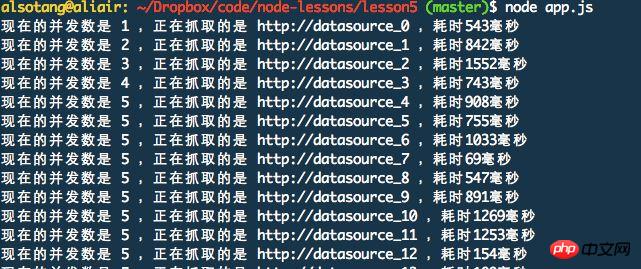
This time I will show you how to use async to control concurrency when operating a node. What are the precautions to use when operating a node to control concurrency using async? The following is a practical case, let’s take a look.
Objective
Create a lesson5 project and write code in it.
The entry point of the code is app.js. When node app.js is called, it will output the titles of all topics on the CNode (https://cnodejs.org/) community homepage. Link and first comment in json format.
Note: Unlike the previous lesson, the number of concurrent connections needs to be controlled at 5.
Output example:
[
{
"title": "【公告】发招聘帖的同学留意一下这里",
"href": "http://cnodejs.org/topic/541ed2d05e28155f24676a12",
"comment1": "呵呵呵呵"
},
{
"title": "发布一款 Sublime Text 下的 JavaScript 语法高亮插件",
"href": "http://cnodejs.org/topic/54207e2efffeb6de3d61f68f",
"comment1": "沙发!"
}
]Knowledge points
##Learn async(https://github.com/caolan/async ) usage of. Here is a detailed async demo: https://github.com/alsotang/async_demoLearn to use async to control the number of concurrent connections.Course content
#lesson4’s code is actually imperfect. The reason why we say this is because in lesson4, we sent 40 concurrent requests at one time. You must know that, except for CNode, other websites may treat you as a malicious request because you send too many concurrent connections. , block your IP. When we write a crawler, if there are 1,000 links to crawl, it is impossible to send out 1,000 concurrent links at the same time, right? We need to control the number of concurrencies, for example, 10 concurrencies, and then slowly capture these 1,000 links. Doing this with async is easy. This time we are going to introduce themapLimit(arr, limit, iterator, callback) interface of async. In addition, there is a commonly used interface for controlling the number of concurrent connections: queue(worker, concurrency). You can go to https://github.com/caolan/async#queueworker-concurrency for instructions.
process control?
My answer is: When you need to go to multiple sources (usually less than 10)The main topic begins. First, we forge a fetchUrl(url, callback) function. The function of this function is that when you call it through
fetchUrl('http://www.baidu.com', function (err, content) {
// do something with `content`
});// 并发连接数的计数器
var concurrencyCount = 0;
var fetchUrl = function (url, callback) {
// delay 的值在 2000 以内,是个随机的整数
var delay = parseInt((Math.random() * 10000000) % 2000, 10);
concurrencyCount++;
console.log('现在的并发数是', concurrencyCount, ',正在抓取的是', url, ',耗时' + delay + '毫秒');
setTimeout(function () {
concurrencyCount--;
callback(null, url + ' html content');
}, delay);
};var urls = [];
for(var i = 0; i < 30; i++) {
urls.push('http://datasource_' + i);
}
async.mapLimit(urls, 5, function (url, callback) {
fetchUrl(url, callback);
}, function (err, result) {
console.log('final:');
console.log(result);
});
How to operate node and use promise instead of callback function
How to use Vue better-scroll to implement the mobile terminal Alphabetical Index Navigation
The above is the detailed content of How to operate node and use async to control concurrency. For more information, please follow other related articles on the PHP Chinese website!




